2023 HYUNDAI IONIQ 6 air condition
[x] Cancel search: air conditionPage 538 of 582
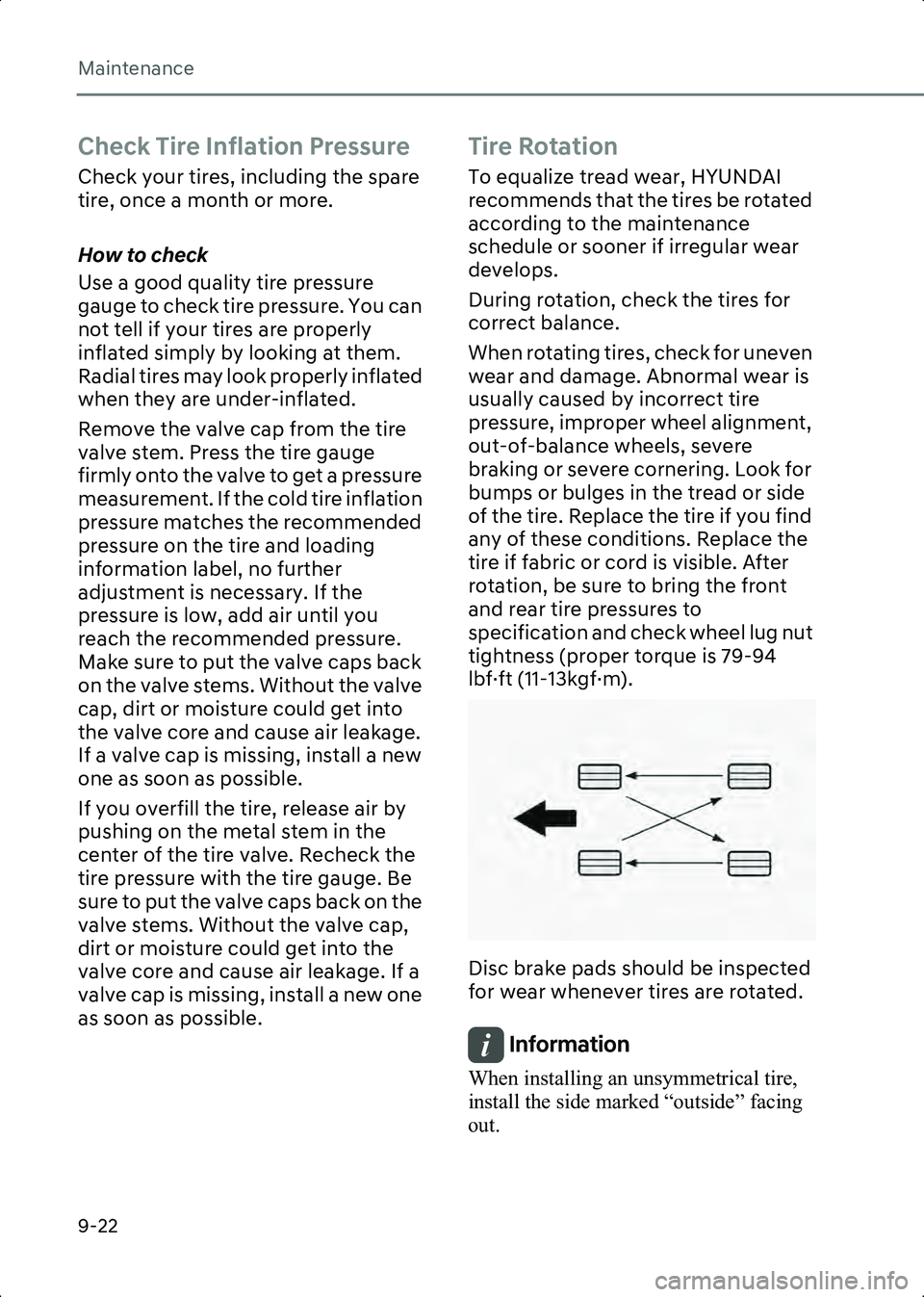
Maintenance
9-22
Check Tire Inflation Pressure
Check your tires, including the spare
tire, once a month or more.
How to check
Use a good quality tire pressure
gauge to check tire pressure. You can
not tell if your tires are properly
inflated simply by looking at them.
Radial tires may look properly inflated
when they are under-inflated.
Remove the valve cap from the tire
valve stem. Press the tire gauge
firmly onto the valve to get a pressure
measurement. If the cold tire inflation
pressure matches the recommended
pressure on the tire and loading
information label, no further
adjustment is necessary. If the
pressure is low, add air until you
reach the recommended pressure.
Make sure to put the valve caps back
on the valve stems. Without the valve
cap, dirt or moisture could get into
the valve core and cause air leakage.
If a valve cap is missing, install a new
one as soon as possible.
If you overfill the tire, release air by
pushing on the metal stem in the
center of the tire valve. Recheck the
tire pressure with the tire gauge. Be
sure to put the valve caps back on the
valve stems. Without the valve cap,
dirt or moisture could get into the
valve core and cause air leakage. If a
valve cap is missing, install a new one
as soon as possible.
Tire Rotation
To equalize tread wear, HYUNDAI
recommends that the tires be rotated
according to the maintenance
schedule or sooner if irregular wear
develops.
During rotation, check the tires for
correct balance.
When rotating tires, check for uneven
wear and damage. Abnormal wear is
usually caused by incorrect tire
pressure, improper wheel alignment,
out-of-balance wheels, severe
braking or severe cornering. Look for
bumps or bulges in the tread or side
of the tire. Replace the tire if you find
any of these conditions. Replace the
tire if fabric or cord is visible. After
rotation, be sure to bring the front
and rear tire pressures to
specification and check wheel lug nut
tightness (proper torque is 79-94
lbf·ft (11-13kgf·m).
B9005001
Disc brake pads should be inspected
for wear whenever tires are rotated.
Information When installing an unsymmetrical tire,
install the side marked “outside” facing
out.
Hyundai_CE_en_US.book Page 22
Page 540 of 582
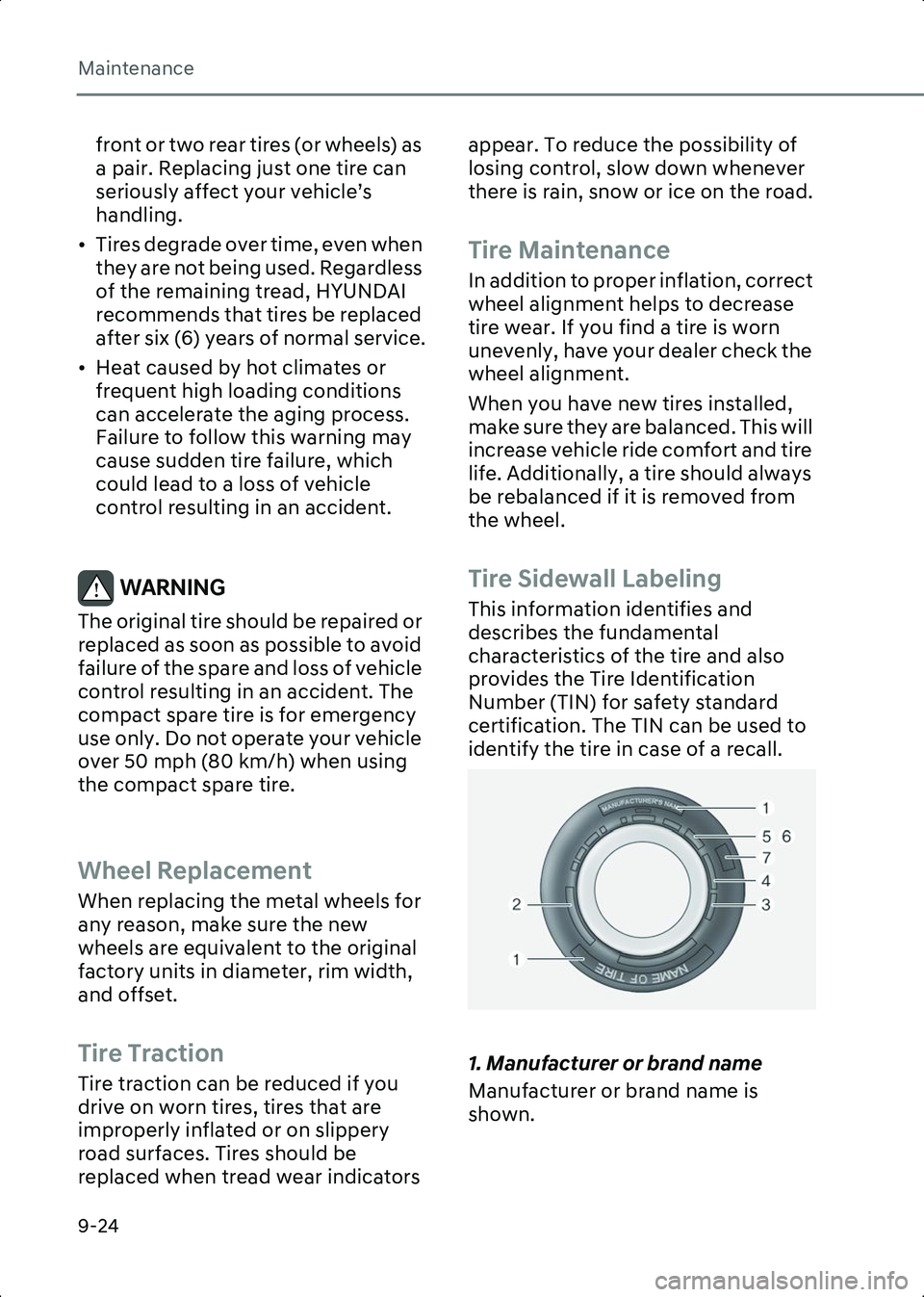
Maintenance
9-24
front or two rear tires (or wheels) as
a pair. Replacing just one tire can
seriously affect your vehicle’s
handling.
• Tires degrade over time, even when they are not being used. Regardless
of the remaining tread, HYUNDAI
recommends that tires be replaced
after six (6) years of normal service.
• Heat caused by hot climates or frequent high loading conditions
can accelerate the aging process.
Failure to follow this warning may
cause sudden tire failure, which
could lead to a loss of vehicle
control resulting in an accident.
WARNING The original tire should be repaired or
replaced as soon as possible to avoid
failure of the spare and loss of vehicle
control resulting in an accident. The
compact spare tire is for emergency
use only. Do not operate your vehicle
over 50 mph (80 km/h) when using
the compact spare tire.
Wheel Replacement
When replacing the metal wheels for
any reason, make sure the new
wheels are equivalent to the original
factory units in diameter, rim width,
and offset.
Tire Traction
Tire traction can be reduced if you
drive on worn tires, tires that are
improperly inflated or on slippery
road surfaces. Tires should be
replaced when tread wear indicators appear. To reduce the possibility of
losing control, slow down whenever
there is rain, snow or ice on the road.
Tire Maintenance
In addition to proper inflation, correct
wheel alignment helps to decrease
tire wear. If you find a tire is worn
unevenly, have your dealer check the
wheel alignment.
When you have new tires installed,
make sure they are balanced. This will
increase vehicle ride comfort and tire
life. Additionally, a tire should always
be rebalanced if it is removed from
the wheel.
Tire Sidewall Labeling
This information identifies and
describes the fundamental
characteristics of the tire and also
provides the Tire Identification
Number (TIN) for safety standard
certification. The TIN can be used to
identify the tire in case of a recall.
B9005401
1. Manufacturer or brand name
Manufacturer or brand name is
shown.
Hyundai_CE_en_US.book Page 24
Page 542 of 582
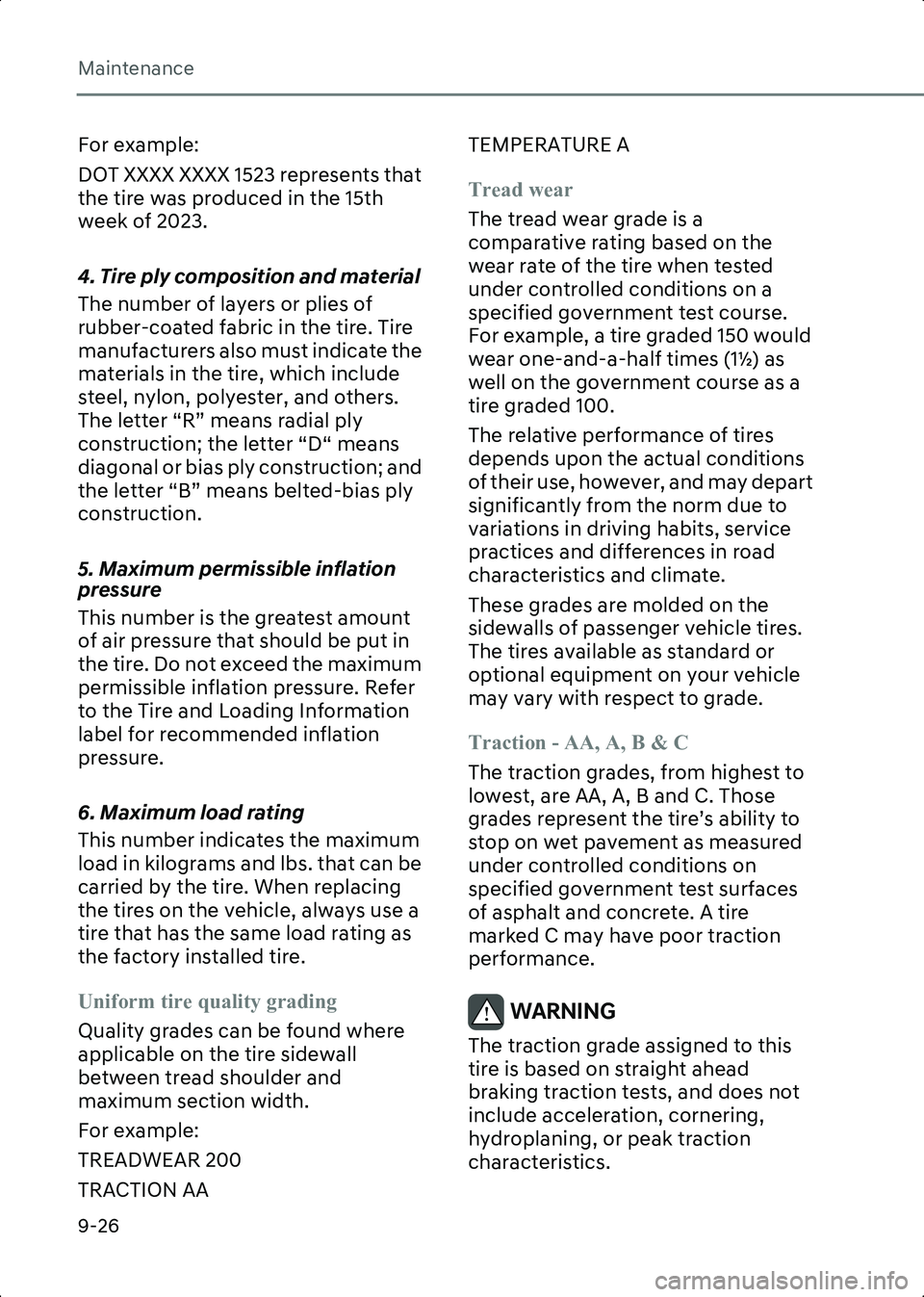
Maintenance
9-26
For example:
DOT XXXX XXXX 1523 represents that
the tire was produced in the 15th
week of 2023.
4. Tire ply composition and material
The number of layers or plies of
rubber-coated fabric in the tire. Tire
manufacturers also must indicate the
materials in the tire, which include
steel, nylon, polyester, and others.
The letter “R” means radial ply
construction; the letter “D“ means
diagonal or bias ply construction; and
the letter “B” means belted-bias ply
construction.
5. Maximum permissible inflation
pressure
This number is the greatest amount
of air pressure that should be put in
the tire. Do not exceed the maximum
permissible inflation pressure. Refer
to the Tire and Loading Information
label for recommended inflation
pressure.
6. Maximum load rating
This number indicates the maximum
load in kilograms and lbs. that can be
carried by the tire. When replacing
the tires on the vehicle, always use a
tire that has the same load rating as
the factory installed tire.
Uniform tire quality grading
Quality grades can be found where
applicable on the tire sidewall
between tread shoulder and
maximum section width.
For example:
TREADWEAR 200
TRACTION AATEMPERATURE A
Tread wear
The tread wear grade is a
comparative rating based on the
wear rate of the tire when tested
under controlled conditions on a
specified government test course.
For example, a tire graded 150 would
wear one-and-a-half times (1½) as
well on the government course as a
tire graded 100.
The relative performance of tires
depends upon the actual conditions
of their use, however, and may depart
significantly from the norm due to
variations in driving habits, service
practices and differences in road
characteristics and climate.
These grades are molded on the
sidewalls of passenger vehicle tires.
The tires available as standard or
optional equipment on your vehicle
may vary with respect to grade.
Traction - AA, A, B & C
The traction grades, from highest to
lowest, are AA, A, B and C. Those
grades represent the tire’s ability to
stop on wet pavement as measured
under controlled conditions on
specified government test surfaces
of asphalt and concrete. A tire
marked C may have poor traction
performance.
WARNING The traction grade assigned to this
tire is based on straight ahead
braking traction tests, and does not
include acceleration, cornering,
hydroplaning, or peak traction
characteristics.
Hyundai_CE_en_US.book Page 26
Page 543 of 582
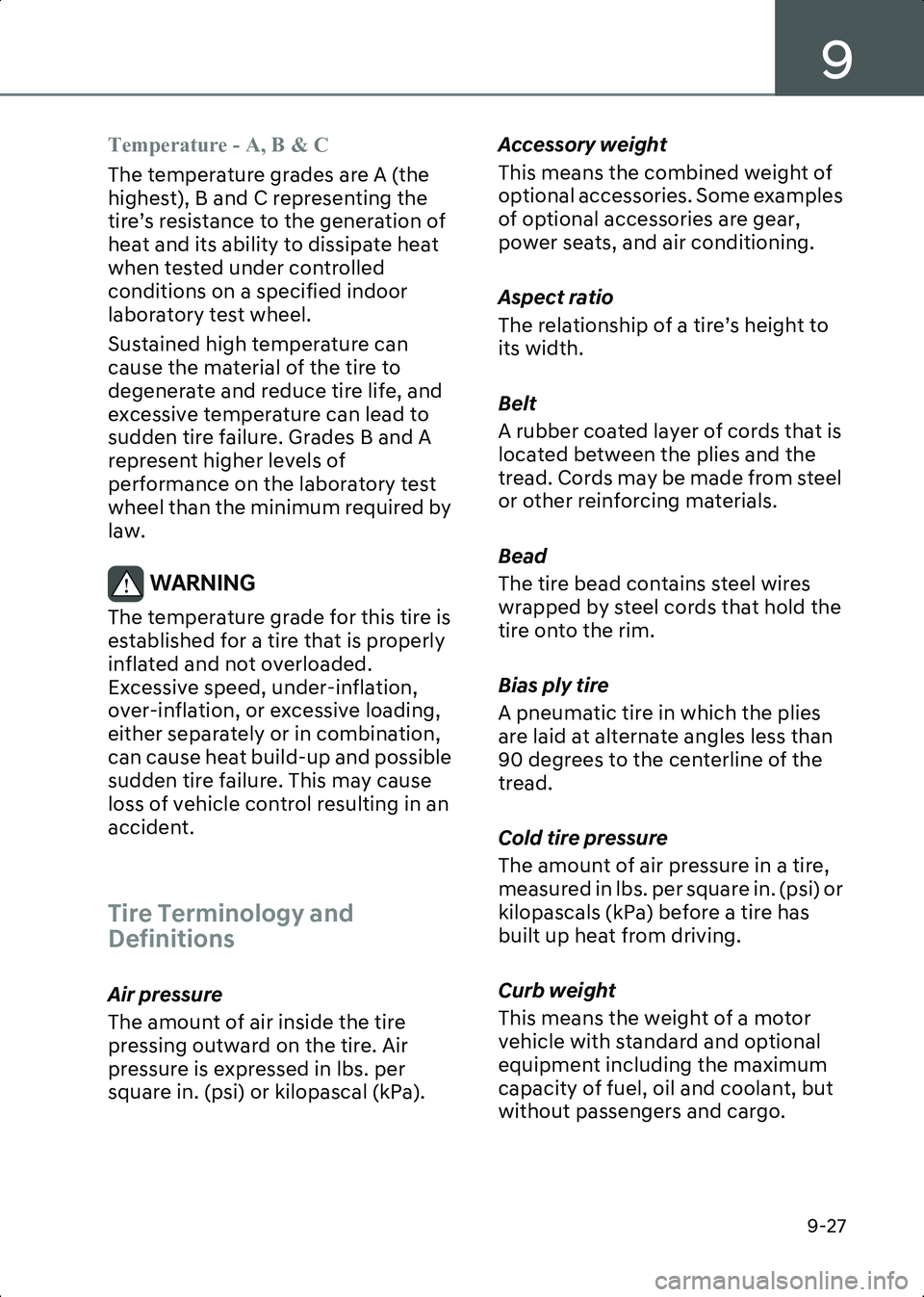
9
9-27
Temperature - A, B & C
The temperature grades are A (the
highest), B and C representing the
tire’s resistance to the generation of
heat and its ability to dissipate heat
when tested under controlled
conditions on a specified indoor
laboratory test wheel.
Sustained high temperature can
cause the material of the tire to
degenerate and reduce tire life, and
excessive temperature can lead to
sudden tire failure. Grades B and A
represent higher levels of
performance on the laboratory test
wheel than the minimum required by
law.
WARNING The temperature grade for this tire is
established for a tire that is properly
inflated and not overloaded.
Excessive speed, under-inflation,
over-inflation, or excessive loading,
either separately or in combination,
can cause heat build-up and possible
sudden tire failure. This may cause
loss of vehicle control resulting in an
accident.
Tire Terminology and
Definitions
Air pressure
The amount of air inside the tire
pressing outward on the tire. Air
pressure is expressed in lbs. per
square in. (psi) or kilopascal (kPa).Accessory weight
This means the combined weight of
optional accessories. Some examples
of optional accessories are gear,
power seats, and air conditioning.
Aspect ratio
The relationship of a tire’s height to
its width.
Belt
A rubber coated layer of cords that is
located between the plies and the
tread. Cords may be made from steel
or other reinforcing materials.
Bead
The tire bead contains steel wires
wrapped by steel cords that hold the
tire onto the rim.
Bias ply tire
A pneumatic tire in which the plies
are laid at alternate angles less than
90 degrees to the centerline of the
tread.
Cold tire pressure
The amount of air pressure in a tire,
measured in lbs. per square in. (psi) or
kilopascals (kPa) before a tire has
built up heat from driving.
Curb weight
This means the weight of a motor
vehicle with standard and optional
equipment including the maximum
capacity of fuel, oil and coolant, but
without passengers and cargo.
Hyundai_CE_en_US.book Page 27
Page 546 of 582
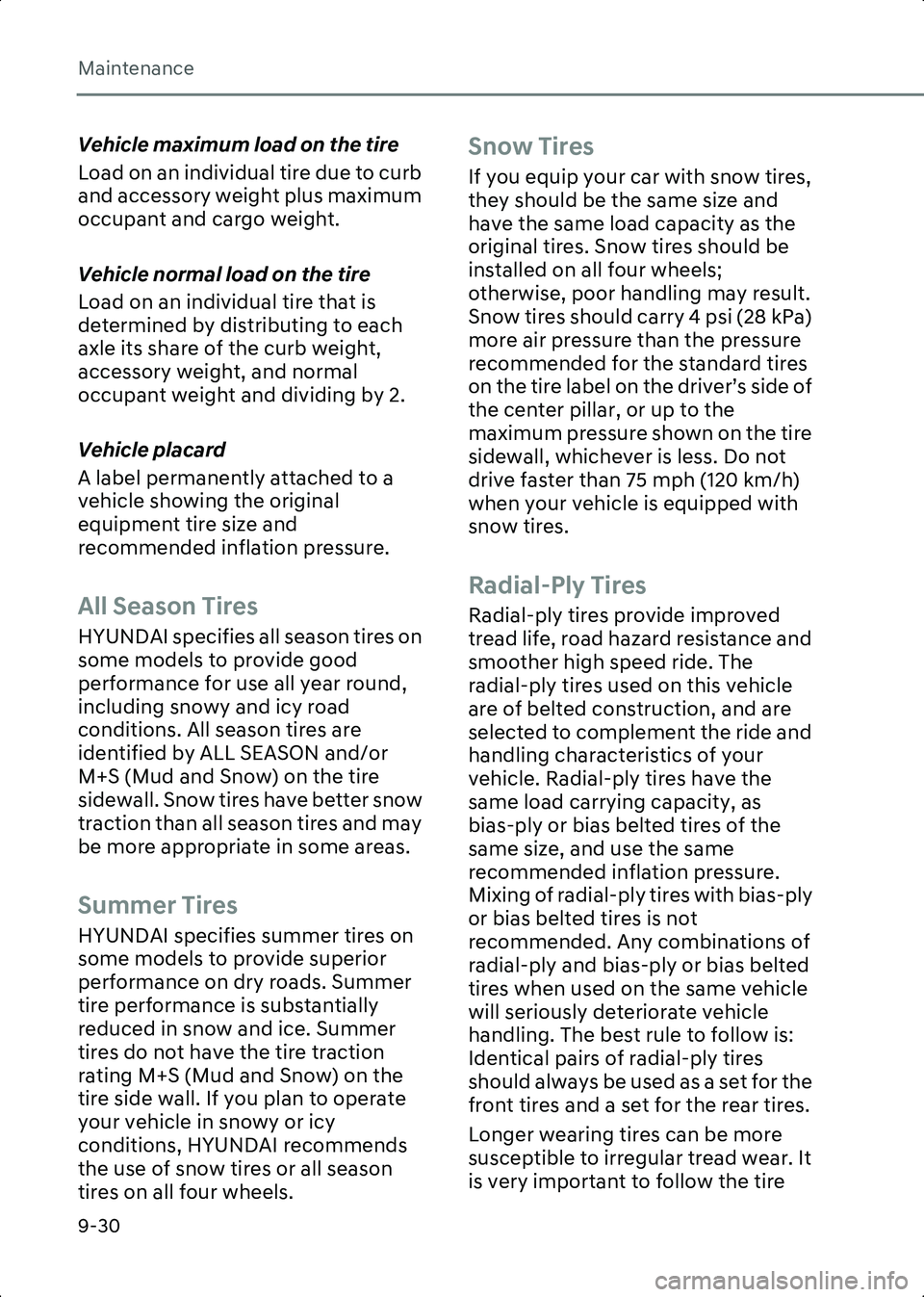
Maintenance
9-30
Vehicle maximum load on the tire
Load on an individual tire due to curb
and accessory weight plus maximum
occupant and cargo weight.
Vehicle normal load on the tire
Load on an individual tire that is
determined by distributing to each
axle its share of the curb weight,
accessory weight, and normal
occupant weight and dividing by 2.
Vehicle placard
A label permanently attached to a
vehicle showing the original
equipment tire size and
recommended inflation pressure.
All Season Tires
HYUNDAI specifies all season tires on
some models to provide good
performance for use all year round,
including snowy and icy road
conditions. All season tires are
identified by ALL SEASON and/or
M+S (Mud and Snow) on the tire
sidewall. Snow tires have better snow
traction than all season tires and may
be more appropriate in some areas.
Summer Tires
HYUNDAI specifies summer tires on
some models to provide superior
performance on dry roads. Summer
tire performance is substantially
reduced in snow and ice. Summer
tires do not have the tire traction
rating M+S (Mud and Snow) on the
tire side wall. If you plan to operate
your vehicle in snowy or icy
conditions, HYUNDAI recommends
the use of snow tires or all season
tires on all four wheels.
Snow Tires
If you equip your car with snow tires,
they should be the same size and
have the same load capacity as the
original tires. Snow tires should be
installed on all four wheels;
otherwise, poor handling may result.
Snow tires should carry 4 psi (28 kPa)
more air pressure than the pressure
recommended for the standard tires
on the tire label on the driver’s side of
the center pillar, or up to the
maximum pressure shown on the tire
sidewall, whichever is less. Do not
drive faster than 75 mph (120 km/h)
when your vehicle is equipped with
snow tires.
Radial-Ply Tires
Radial-ply tires provide improved
tread life, road hazard resistance and
smoother high speed ride. The
radial-ply tires used on this vehicle
are of belted construction, and are
selected to complement the ride and
handling characteristics of your
vehicle. Radial-ply tires have the
same load carrying capacity, as
bias-ply or bias belted tires of the
same size, and use the same
recommended inflation pressure.
Mixing of radial-ply tires with bias-ply
or bias belted tires is not
recommended. Any combinations of
radial-ply and bias-ply or bias belted
tires when used on the same vehicle
will seriously deteriorate vehicle
handling. The best rule to follow is:
Identical pairs of radial-ply tires
should always be used as a set for the
front tires and a set for the rear tires.
Longer wearing tires can be more
susceptible to irregular tread wear. It
is very important to follow the tire
Hyundai_CE_en_US.book Page 30
Page 566 of 582

Maintenance
9-50
Corrosion protection
Protecting your vehicle from corrosion
By using the most advanced design and
construction practices to combat
corrosion, HYUNDAI produces vehicles of
the highest quality. However, this is only
part of the job. To achieve the long-term
corrosion resistance your vehicle can
deliver, the owner’s cooperation and
assistance is also required.
Common causes of corrosion
The most common causes of corrosion on
your vehicle are:
• Road salt, dirt and moisture that is allowed to accumulate underneath the
vehicle.
• Removal of paint or protective coatings by stones, gravel, abrasion or minor
scrapes and dents which leave
unprotected metal exposed to
corrosion.
High-corrosion areas
If you live in an area where your vehicle is
regularly exposed to corrosive materials,
corrosion protection is particularly
important. Some of the common causes
of accelerated corrosion are road salts,
dust control chemicals, ocean air and
industrial pollution.
Moisture breeds corrosion
Moisture creates the conditions in which
corrosion is most likely to occur. For
example, corrosion is accelerated by high
humidity, particularly when temperatures
are just above freezing. In such
conditions, the corrosive material is kept
in contact with the vehicle surfaces by
moisture that is slow to evaporate.
Mud is particularly corrosive because it is
slow to dry and holds moisture in contact
with the vehicle. Although the mud
appears to be dry, it can still retain
moisture and promote corrosion. High temperatures can also accelerate
corrosion of parts that are not properly
ventilated so the moisture can be
dispersed. For all these reasons, it is
particularly important to keep your
vehicle clean and free of mud or
accumulations of other materials. This
applies not only to the visible surfaces but
particularly to the underside of the
vehicle.
To help prevent corrosion
Keep your vehicle clean
The best way to prevent corrosion is to
keep your vehicle clean and free of
corrosive materials. Attention to the
underside of the vehicle is particularly
important.
• If you live in a high-corrosion area -
where road salts are used, near the
ocean, areas with industrial pollution,
acid rain, etc., -, you should take extra
care to prevent corrosion. In winter,
hose off the underside of your vehicle
at least once a month and be sure to
clean the underside thoroughly when
winter is over.
• When cleaning underneath the vehicle, pay particular attention to the
components under the fenders and
other areas that are hidden from view.
Do a thorough job; just dampening the
accumulated mud rather than washing
it away will accelerate corrosion rather
than prevent it. Water under high
pressure and steam are particularly
effective in removing accumulated
mud and corrosive materials.
• When cleaning lower door panels, rocker panels and frame members, be
sure that drain holes are kept open so
that moisture can escape and not be
trapped inside to accelerate corrosion.
Keep your garage dry
Don’t park your vehicle in a damp, poorly
ventilated garage. This creates a
favorable environment for corrosion. This
Hyundai_CE_en_US.book Page 50
Page 572 of 582
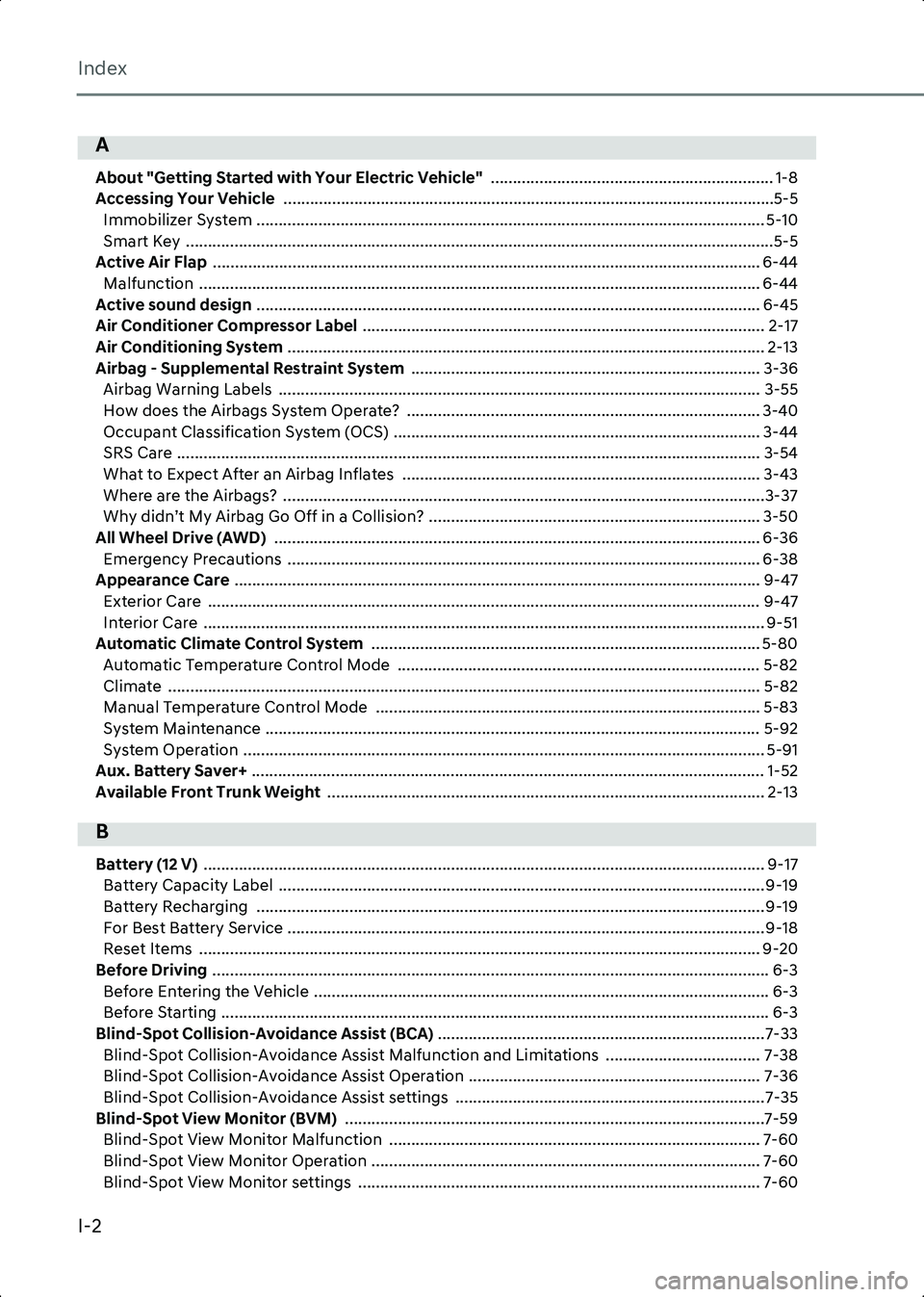
Index
I-2
A
About "Getting Started with Your Electric Vehicle" ................................................................ 1-8
Accessing Your Vehicle ...............................................................................................................5-5
Immobilizer System ................................................................................................................... 5-10
Smart Key .....................................................................................................................................5-5
Active Air Flap ............................................................................................................................ 6-44
Malfunction ............................................................................................................................... 6-44
Active sound design .................................................................................................................. 6-45
Air Conditioner Compressor Label ........................................................................................... 2-17
Air Conditioning System ............................................................................................................ 2-13
Airbag - Supplemental Restraint System ............................................................................... 3-36
Airbag Warning Labels ............................................................................................................. 3-55
How does the Airbags System Operate? ................................................................................ 3-40
Occupant Classification System (OCS) ................................................................................... 3-44
SRS Care .................................................................................................................................... 3-54
What to Expect After an Airbag Inflates ................................................................................. 3-43
Where are the Airbags? .............................................................................................................3-37
Why didn’t My Airbag Go Off in a Collision? ........................................................................... 3-50
All Wheel Drive (AWD) .............................................................................................................. 6-36
Emergency Precautions ........................................................................................................... 6-38
Appearance Care ....................................................................................................................... 9-47
Exterior Care ............................................................................................................................. 9-47
Interior Care ............................................................................................................................... 9-51
Automatic Climate Control System ........................................................................................ 5-80
Automatic Temperature Control Mode .................................................................................. 5-82
Climate ...................................................................................................................................... 5-82
Manual Temperature Control Mode ....................................................................................... 5-83
System Maintenance ................................................................................................................ 5-92
System Operation ...................................................................................................................... 5-91
Aux. Battery Saver+ .................................................................................................................... 1-52
Available Front Trunk Weight ................................................................................................... 2-13
B
Battery (12 V) ............................................................................................................................... 9-17
Battery Capacity Label .............................................................................................................. 9-19
Battery Recharging ...................................................................................................................9-19
For Best Battery Service ............................................................................................................9-18
Reset Items ............................................................................................................................... 9-20
Before Driving .............................................................................................................................. 6-3
Before Entering the Vehicle ....................................................................................................... 6-3
Before Starting ............................................................................................................................ 6-3
Blind-Spot Collision-Avoidance Assist (BCA) ..........................................................................7-33
Blind-Spot Collision-Avoidance Assist Malfunction and Limitations ................................... 7-38
Blind-Spot Collision-Avoidance Assist Operation .................................................................. 7-36
Blind-Spot Collision-Avoidance Assist settings ......................................................................7-35
Blind-Spot View Monitor (BVM) ...............................................................................................7-59
Blind-Spot View Monitor Malfunction .................................................................................... 7-60
Blind-Spot View Monitor Operation ........................................................................................ 7-60
Blind-Spot View Monitor settings ........................................................................................... 7-60
Hyundai_CE_en_US.book Page 2
Page 574 of 582
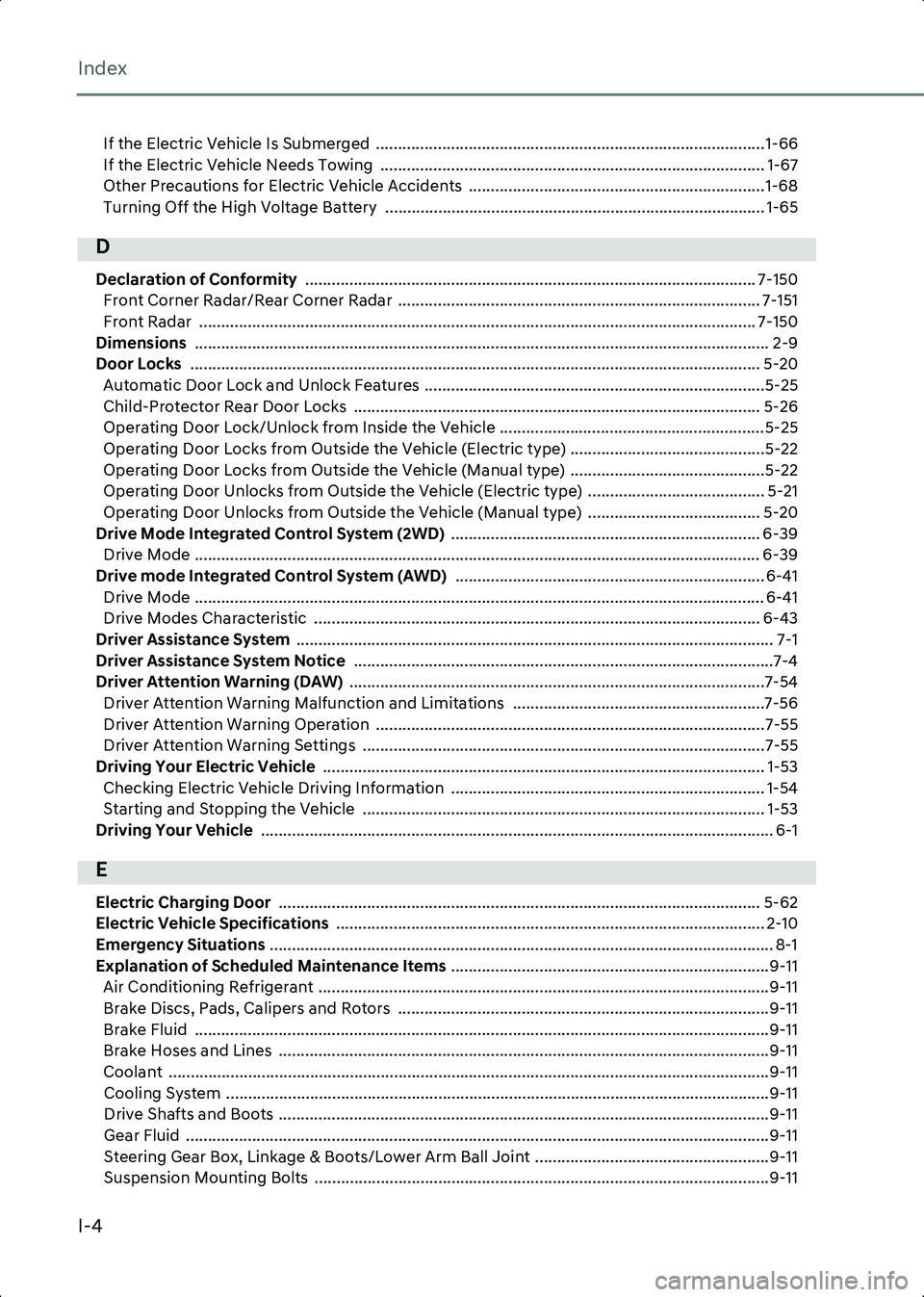
Index
I-4
If the Electric Vehicle Is Submerged ........................................................................................1-66
If the Electric Vehicle Needs Towing ....................................................................................... 1-67
Other Precautions for Electric Vehicle Accidents ................................................................... 1-68
Turning Off the High Voltage Battery ...................................................................................... 1-65
D
Declaration of Conformity ...................................................................................................... 7-150Front Corner Radar/Rear Corner Radar .................................................................................. 7-151
Front Radar .............................................................................................................................. 7-150
Dimensions .................................................................................................................................. 2-9
Door Locks ................................................................................................................................. 5-20
Automatic Door Lock and Unlock Features .............................................................................5-25
Child-Protector Rear Door Locks ............................................................................................ 5-26
Operating Door Lock/Unlock from Inside the Vehicle ............................................................5-25
Operating Door Locks from Outside the Vehicle (Electric type) ............................................5-22
Operating Door Locks from Outside the Vehicle (Manual type) ............................................5-22
Operating Door Unlocks from Outside the Vehicle (Electric type) ........................................ 5-21
Operating Door Unlocks from Outside the Vehicle (Manual type) ....................................... 5-20
Drive Mode Integrated Control System (2WD) ...................................................................... 6-39
Drive Mode ................................................................................................................................ 6-39
Drive mode Integrated Control System (AWD) ...................................................................... 6-41
Drive Mode ................................................................................................................................. 6-41
Drive Modes Characteristic ..................................................................................................... 6-43
Driver Assistance System ............................................................................................................ 7-1
Driver Assistance System Notice ...............................................................................................7-4
Driver Attention Warning (DAW) ..............................................................................................7-54
Driver Attention Warning Malfunction and Limitations .........................................................7-56
Driver Attention Warning Operation ........................................................................................7-55
Driver Attention Warning Settings ...........................................................................................7-55
Driving Your Electric Vehicle .................................................................................................... 1-53
Checking Electric Vehicle Driving Information ....................................................................... 1-54
Starting and Stopping the Vehicle ........................................................................................... 1-53
Driving Your Vehicle .................................................................................................................... 6-1
E
Electric Charging Door ............................................................................................................. 5-62
Electric Vehicle Specifications ................................................................................................. 2-10
Emergency Situations .................................................................................................................. 8-1
Explanation of Scheduled Maintenance Items ........................................................................9-11
Air Conditioning Refrigerant ......................................................................................................9-11 Brake Discs, Pads, Calipers and Rotors ....................................................................................9-11
Brake Fluid ..................................................................................................................................9-11
Brake Hoses and Lines ...............................................................................................................9-11
Coolant ........................................................................................................................................9-11Cooling System ...........................................................................................................................9-11
Drive Shafts and Boots ...............................................................................................................9-11
Gear Fluid ....................................................................................................................................9-11
Steering Gear Box, Linkage & Boots/Lower Arm Ball Joint .....................................................9-11Suspension Mounting Bolts .......................................................................................................9-11
Hyundai_CE_en_US.book Page 4